
[Source:
Martin James]
Click here for Halwill Gallery 6: c1965 - 1975 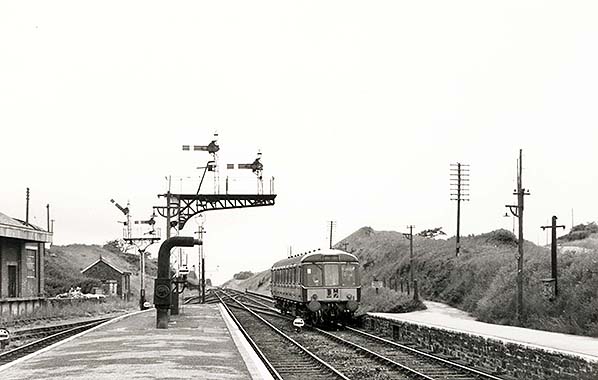 Examination of a larger version of this photograph suggests that the track into the Torrington bay, centre background, at Halwill has either been lifted or is heavily overgrown, most likely the latter, whilst directly ahead of the camera the water column has lost its bag. Both of these observations would suggest that the photograph was taken in the late 1965 into 1966 period. The run-round loop for Torrington trains is, however, in situ but also overgrown. A single-unit railcar, later Class 122, is arriving from Bude. At far left, the tracks into the goods yard and especially that serving the goods shed appear little used. The road is set for the Launceston and Wadebridge route. To the immediate right of the shunt signal mounted on the signal post can be seen, under magnification, the lower quadrant signal on the branch which is also in the 'off' position. For some reason certain LSWR signals survived when others, as seen here, were converted to upper quadrant. On the right a Southern 'target' nameplate can be seen. It is on the lamp post largely invisible by virtue of the camera position placing the lamp post directly in line with the telegraph pole behind it.
Photo from John Mann collection 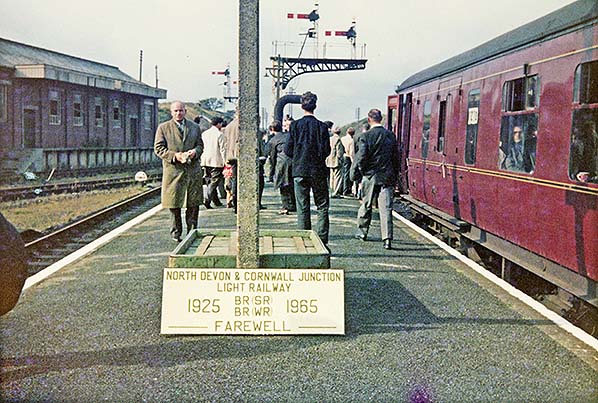 The sign on the platform explains the occasion. The North Devon & Cornwall Junction Light Railway was an extension of the LSWR's Torrington branch and part of the light railway had been rebuilt from its original 3ft gauge clay tramway form. The Halwill to Torrington section closed to passengers on 1 March 1965, freight other than clay traffic having gone in September of the previous year, and the Meeth - Halwill section closed completely and the was track lifted. The section between Meeth and Barnstaple, however, remained in use for clay traffic until March 1983. The carriage on the right was ex GWR and in one of its windows is a label displaying 1Z10, this being the headcode assigned to the train with 'Z' being used for any special train such as railtours, excursions or private charters. The Halwill slaughter house, which had its own loading dock, is seen on the left. Compare with early twentieth pictures. The slaughterhouse was rebuilt by the Southern Railway in 1930.
Photo from John Mann collection 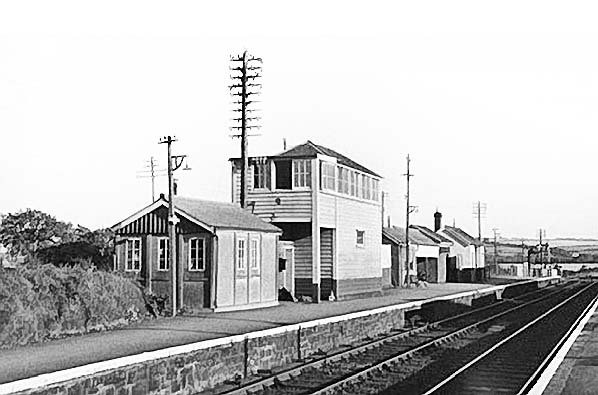 A fairly rare view of Halwill up platform in that the view is unobscured by trains and clouds of steam. Whilst the camera angle is not ideal, the picture may be of some interest to modellers. The date is unknown but it is from late BR days. Electric lighting is present, this having been installed sometime during the 1930s. Oil lighting is known to have still been in use in 1931. Dominating the scene is the monstrous carbuncle of a signal box. The type of LSWR box was never particularly attractive but that at Halwill was more ungainly than most. There is much evidence of Exmouth Junction Concrete Works. This had been opened by the LSWR but in the mid 1920s the Southern Railway considerably enlarged it and thereafter its products flooded the system. Visible here are, for example, concrete lamp standards of the typical Exmouth style and the hut, probably a lamp room, directly ahead of the camera. Further along the platform are other small stores huts and the waiting shelter. Southern Railway 'target' namebplates are visible and in later years one also appeared on the pillar supporting the overhanging part of the signal box. A further feature to note is the stone platform facing, quite typical of rural West Country stations. A fairly rare view of Halwill up platform in that the view is unobscured by trains and clouds of steam. Whilst the camera angle is not ideal, the picture may be of some interest to modellers. The date is unknown but it is from late BR days. Electric lighting is present, this having been installed sometime during the 1930s. Oil lighting is known to have still been in use in 1931. Dominating the scene is the monstrous carbuncle of a signal box. The type of LSWR box was never particularly attractive but that at Halwill was more ungainly than most. There is much evidence of Exmouth Junction Concrete Works. This had been opened by the LSWR but in the mid 1920s the Southern Railway considerably enlarged it and thereafter its products flooded the system. Visible here are, for example, concrete lamp standards of the typical Exmouth style and the hut, probably a lamp room, directly ahead of the camera. Further along the platform are other small stores huts and the waiting shelter. Southern Railway 'target' namebplates are visible and in later years one also appeared on the pillar supporting the overhanging part of the signal box. A further feature to note is the stone platform facing, quite typical of rural West Country stations.Photo by Chris Knowlses-Thomas junction_old4.jpg)
A 1966 view at Halwill looking south and with plenty of DMUs in evidence. Around this time, the Western Region made some changes to headcodes and two are apparent here. The train at the up platform is a Class 117 unit and is heading for Okehampton and possibly through to Exeter. Class 117 was more familiar on suburban services out of Paddington but a few were based at Laira. Entering the down platform is a pair of single-unit railcars, the leading car being a Gloucester RC&W Class 122 and this ensemble will be heading for Padstow. In the bay stands a BR Swindon unit of Class 120 and one of a batch built for the Western Region with 4-character headcode boxes. It appears to be in 2-car formation so has had its centre trailer removed - a not uncommon occurrence and especially in later years. The Class 120 will be heading for Bude but the headcode is something of a puzzle as '3' indicated a parcels or empty stock working. Perhaps the driver, suspected here of being the gentleman walking towards the cab carrying the accoutrements of the job, will change it. The headcode for Halwill - Bude and vice versa diesel trains was formerly 2C77. Although only a very small part of the goods yard is visible on the right, the impression is gained that it was by then all but out of use insofar as rail traffic was concerned.
junction_old21.jpg) Halwill station in July 1966 and not all is as it may first appear. Train 2C77, for Bude, is not a pair of single-unit railcars coupled together but two driving motor cars, one a brake, from a normally 3-car Class 117 DMU. These units are best known for operating suburban services out of Paddington but a number also operated from Laira (Plymouth). Built by Pressed Steel, that company's single-unit Class 121 was effectively a double-ended version of a Class 117 Driving Motor Brake, the vehicle furthest from the camera in this view. In the bay a Gloucester RC&W single-unit railcar is seen. The lack of activity suggests it is on layover and will work a later service to Bude or perhaps Padstow, although services to the latter appear t have generally used the main platforms. For a change, the only member of staff visible is the DMU driver. His right hand appears to be on the vacuum brake handle but the train is not about to move as a passenger door is open. What is probably happening is the driver has just entered the cab and is setting up the controls. DMU controls had a detachable reverser key and brake handle, just one set per unit, which had to be transferred from one cab to the other and this is probably what the driver has just done in this view. DMUs also had a key similar to the common Yale type which was used to 'switch on' the driver’s desk. Again this key was transferred from one cab to the other but unlike the detachable controls these keys were issued to, and retained by, drivers.
Photo by M. Taylor junction_old22.jpg) Halwill station’s down platform running-in board is seen here in July 1966. Of note is the still-present reference to Torrington despite that line having closed the previous year. Perhaps there was a replacement bus service, if so the board retained a little validity. On the left the stationmaster's house can be seen and on the right, with the 'Walls' sign, above a shop. The building largely hidden by the running-in board was the West Devon & North Cornwall Farmers’ Co-operative (this had no connection with the ‘Co-op’ chain of stores). Beneath the 'RR' of Torrington the Halwill Junction war memoria can be seen. A selection of period road vehicles is visible. The lorry at far left appears to be an Austin FFK. Not all others can be identified, as they are largely hidden, but what can be seen are a Rover P4 and probably a 90, behind the Rover a Mini van, to the right of the Rover a Morris/BMC J2 delivery van, in front of the shop an Austin A40 Farina and standing out from them all is a Ford Consul MkII.
Photo by M. Taylor old70.jpg) Halwill buzzes with activity in this view taken on 1 October 1966, the final day of service on the Okehampton - Bude/Wadebridge lines. Padstow and Wadebridge were, of course, to remain open a little longer for services from Bodmin and by October 1966 there were no trains to or from Padstow via Halwill, passengers needing to change at Wadebridge. The train on the left has arrived from the Okehampton direction and is formed of a Class 122 single-unit plus another unit of some description (a 3-car set is known have been in use on the final day as well as the single-units). The photographer did not record the time of the photograph. However, Halwill station was aligned on a SSE - NNW axis so in knowing the date and by examining length and direction of shadows we can determine that this photograph was taken during the late morning to midday period. From the timetable, reproduced on the Halwill main page, we can determine the train on the left was the 11:45 ex-Okehampton, arrive Halwill 12:06. The train then divided with the front portion departing for Bude at 12:09 and the rear portion departing for Wadebridge at 12:10. The driver of the single-unit which will form the 12:10 departure is in the cab, chatting to the driver of the single-unit on the right which had arrived from Bude at 12:07. This service, ex-Bude 11:30, continued to Okehampton arrive 12:35. The headboard on the ex-Bude unit, unreadable in this view, bore basic representations of the Coats of Arms of Okehampton, left, and Bude, right. Wording was '1898 - 1966 Okehampton - Bude Last day' and the board is known to have been fixed to the final departure from Bude so presumably was on show for most of the day and is known to have adorned the final departure from Bude at 19:35. It is worth adding a comment about the final timetable for Halwill. A study of the timetable suggests passengers to or from the Wadebridge line were required to change at Halwill from or onto Bude - Okehampton, or vice versa, services but this was not the case as the majority of services joined or divided at Halwill and thus in actuality provided through services between Okehampton or Exeter and the Wadebridge line. This was one of the advantages of diesel multiple units, making the joining and dividing of trains much simpler than with
locomotive-hauled services. Photo by Roger Joanes old71.jpg)
On 1 October 1966 the last train on the North Cornwall Line has arrived at Halwill and will shortly continue to Okehampton and Exeter. The train is formed of two single-unit diesel railcars, that leading being a Gloucester RC&W Class 122. This train was 18:40 ex-Wadebridge, from where it departed as a single-unit. The second unit was attached at Launceston. There were two short journeys between Halwill and Launceston; 07:48 ex-Launceston and 19:00 ex-Halwill but precisely what this train did overnight is unclear. It either stabled overnight at Launceston, or ran empty to depot then returning empty to Launceston the following morning, or, as happened on the final day, returned to Exeter by attaching to the 18:40 ex-Wadebridge and then running empty stock to Launceston the following weekday morning - post last day obviously excepted. Only the relevant working, as opposed to public, timetable would answer this question and we do not have a copy of this. Whatever the answer, we know that on the final day the unit operated the 19:00 ex-Halwill, arriving Launceston 19:21, then was attached to the 18:40 ex-Wadebridge at Launceston at 19:45. The ensemble than arrived Halwill 20:08 and this was the end of the North Cornwall Line from Wadebridge. The final down train to Wadebridge was the 16:50 ex-Okehampton, arriving Wadebridge 18:34, returning with the 18:40 departure. Meanwhile the last train from Bude had departed the latter at 19:35 and was due to arrive Halwill 2013. On doing so it coupled to the waiting 20:08 arrival from Wadebridge and at 20:19 the expanded ensemble rasped away to Exeter Central where it was due to arrive 21:36. Once it passed Meldon Junction and reached Okehampton at 20:46 this was the end of the railway through Halwill insofar as the public were concerned. When a railway closed, after the final passenger train, or goods as the case may be, photographers and enthusiasts usually considered it to be the end and turned their backs. However, in most cases the rails were polished once again as the demolition trains arrived to perform their work and these were the very last trains over the lines concerned but regretfully few photographers bothered to record them and this appears to have been the case with Halwill. A common scenario was contractors using their own small diesel locomotive with loaded trains of materials being taken away by BR. For example, the ex-GWR route through Launceston was lifted in this way with contractors using a Fowler diesel of the same type as BR's ED2 - 6 and with loaded trains removed at intervals by BR. Photographs of demolition trains at Launceston (GWR) exist as does a single and very unclear photograph said to be of the Padstow demolition train but that would appear to be it insofar as the area in question is concerned.
Photo by Roger Joanes 11.jpg) Halwill Station looking north in September 1967 shortly after the track was lifted. Some of the up platform buildings were still intact at this time although the signal box has been demolished. Halwill Station looking north in September 1967 shortly after the track was lifted. Some of the up platform buildings were still intact at this time although the signal box has been demolished.Copyright photo by John Alsop 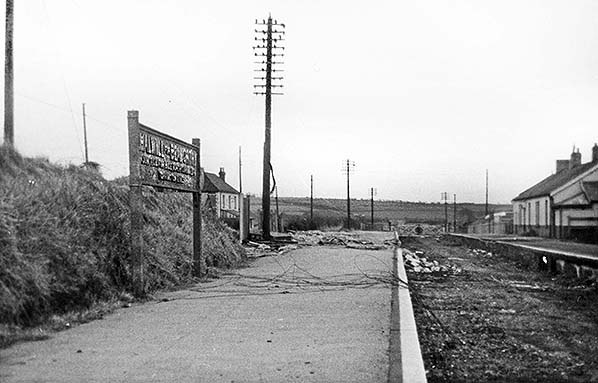 Another view of Halwill station in 1967, shortly after track-lifting, looking south. The remaining up platform buildings have now gone.
Photo by G Roose 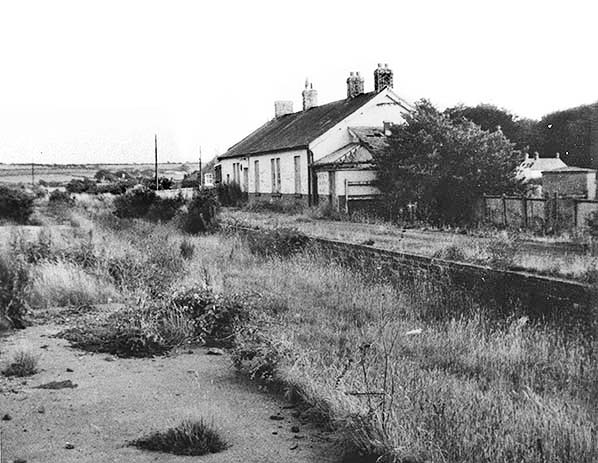
Looking south from the up platform at Halwill station in 1975.
Photo from John Mann collection 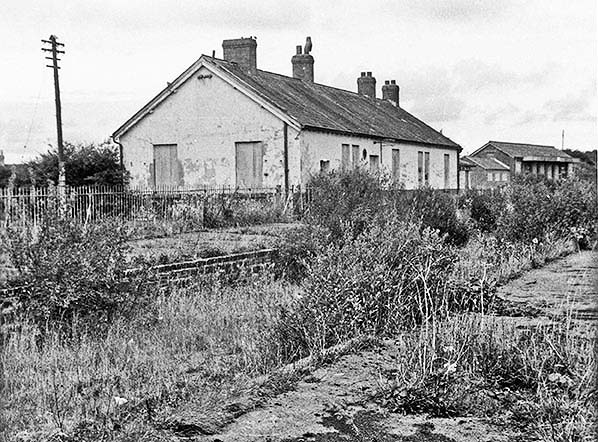
The main station building at Halwill seen from the up platform in 1975. The slaughterhouse is seen in the background.
Photo from John Mann collection 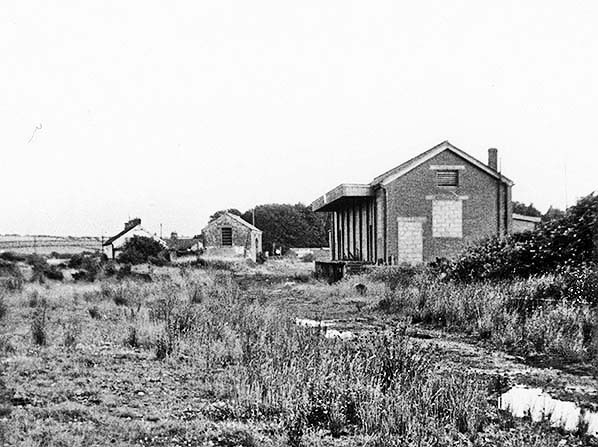
Looking south at the Halwill goods yard in 1975. The buildings seen from left to right are the main station building, goods shed and slaughterhouse. The turntable was beyond the goods shed but is always obscured from view by the slaughterhouse.
Photo from John Mann collection 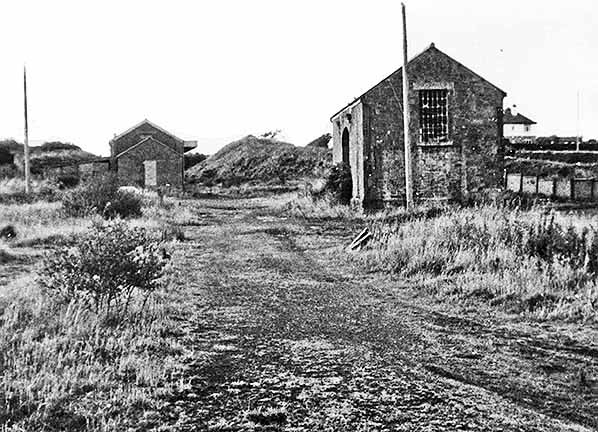 Looking north at the Halwill goods yard in 1975. The goods shed is on the right with the slaughterhouse on the left. The turntable pit is behind and to the left of the photographer.
Photo from John Mann collection Click here for Halwill Gallery 7: July 1975 - Spring 1985 |

 Home Page
Home Page